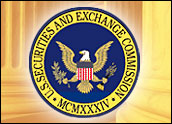
The Securities and Exchange Commission (SEC) cast a preliminary vote in favor of new rules that would force public companies to more fully report how much top executives are being paid, with everything from stock grants and bonuses to non-cash perks subject to disclosure.
The five-member commission held a meeting Tuesday to discuss the issue and voted unanimously to move the guidelines forward in the two-step approval process. A final vote will be scheduled after a public comment period of 60 days, but it is likely to take place late this year.
Keeping Investors Informed
The rules will require all publicly traded companies to disclose in their annual reports a single number for the compensation of several top executives, including the CEO, chief financial officer and the next three highest-paid executives. Currently, most companies disclose pay in their annual shareholder proxy statements, but the data is often contained in various tables and spreadsheets, rather than in a single location.
The rules are designed to give investors more and better information — not to limit CEO pay in any way, said SEC Chairman Christopher Cox.
“It is about wage clarity, not wage controls,” he asserted.
“Our disclosure rules haven’t kept pace with changes in the marketplace,” Cox pointed out, noting that rules for releasing pay data were last changed in 1992.
“This information is information shareholders have a right to know,” added Commissioner Cynthia Glassman during the meeting, which was webcast from SEC headquarters in Washington, D.C.
The new rules would require disclosing all non-cash perks worth over US$10,000 instead of the current $50,000, which might include car allowances, executive apartments or free travel. However, rules on option accounting were seen as the most controversial part of the overhaul.
Option Play
The stock options disclosure rule will require companies to assign a standard cash value to options, something many companies do not do — or do based on their own formulas and predictions of future stock value.
That provision may be the subject of intense lobbying from business groups and others during the comment period.
The information would be included in annual reports and would also be accompanied by an explanation of why a company paid an executive the way it did, the SEC said.
The kickoff meeting was meant to raise awareness of the proposals and to attract additional comment before a final decision is rendered, SEC spokesperson Kieran Brown told the E-Commerce Times.
The U.S. Chamber of Commerce has expressed some concern about the proposed changes but has yet to take a formal stand or to say whether it intends to lobby against their adoption.
Impact Debated
The “geography of executive pay” will be impacted by the changes, Joseph Rich, president of executive compensation consulting firm Pearl Meyer & Associates, told the E-Commerce Times.
“They’re buttoning up areas that we’ve known for years are not as fully disclosed as others, such as deferred compensation and pensions,” he explained. “Some elements of the compensation package may be more tainted than others, so you might see, for instance, a reduction in the use of perks.”
The eventual upshot will be higher pay for top executives, Rich predicted.
“There was a lot of protestation from the SEC that they don’t want to raise pay, but I think that this will actually increase compensation across the board,” he said. “Maybe perks get reduced, but it’s not unusual that when you take away a perk or some other element of compensation you make it up elsewhere.”
The proposed changes would have “little impact” on how much CEOs are being paid, according to New York University professor of finance David Yermack.
One positive consequence could be additional awareness among boards of directors of what CEOs actually earn through pensions and other perks, he added. Yermack’s research includes a study that found excessive use of a corporate jet by a CEO is often associated with a decline in a company’s stock value over time.
Pay for Performance
It is no secret that CEO pay has continued to climb dramatically, even though many of the companies they helm have fallen on hard times or been forced to lay off workers. While the SEC proposals do not seek to tie pay to performance, having access to the new data would make it easier for investors to make decisions about executive pay, the agency noted.
Investors should gain more information about what will happen when a CEO leaves a company or a merger takes place, Rich said, since those details have been buried in contract documents and other filings in the past.
“In a lot of cases, it’s already been in there, but you had to know where to look,” he explained.
As to the push to tie pay more closely to performance — that already happens, Rich argued, but it may only be evident if you take the long view.
“I think CEO pay is tied to performance over time. A high-performing CEO will stay longer at a company, so his pay goes up. He performs well, so his bonus is higher. The hard part is figuring out the time frame to use in measuring performance,” he suggested.















































Social Media
See all Social Media